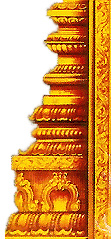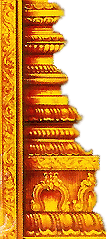Aadi Thapasu festival: Thapas means penance. Mother Parvathi took to penance to have the darshan of Lord Shiva and Lord Vishnu combined as Sankara Narayana. This is the festival called Aadi Thapasu running for 12 days. As this is a festival exclusively for Ambica, She alone comes in the car procession. On the last day, Ambica goes to the Thapas Mandapa with a bag of sacred ashes – Vibhuti. Lord Sankaranarayana grants darshan to Ambica in the evening and enters the temple on the elephant vahan together.
While Annabishekam is performed in Shiva temples in Aipasi-October-November, this takes place here on the first day of Aipasi and also in Chithirai-April-May with a prayer that the year should begin without shortage of food grains in the beginning of the year (Chithirai is the fist month of Tamil year) and Aipasi happens to be the beginning of auspicious days.
It is also noteworthy that Vaikunda Ekadasi in December-January is celebrated with equal festivity as in Vishnu temples for which a Sorga Vasal is constructed in the temple. Lord Vishnu grants darshan in a palanquin in reclining form.
There is a shrine for Lord Vanmeeka Nathar in the Shiva prakara. Lord Shiva in this shrine appears in an ant-hill form, his true form. It is designed as if He is sitting on a serpent with its head above Him as an umbrella. Vanmeekam means ant-hill. As Lord Shiva is in the Vanmeekam, He is praised as Vanmeekanathar. Those afflicted with adverse snake planet aspects, pray in the shrine spraying turmeric powder. There are five Naga idols before this shrine. Devotees perform abishek to these idols with milk.
Tooth pain prayer: As a tradition, Lord Lingodhbava or Lord Vishnu grace on the goshta wall around the sanctum. In this temple, this slot is occupied by Lord Yoga Narasimha. Those suffering from tooth ache pray here with abishek for relief from pain. Special pujas are offered here on Purattasi Saturdays in September-October.
There is a shrine for Lord Sarpa Vinayaka – Vinayaka with a Serpent in hand. Those facing adverse effects serpent planet Ragu, worship here at Rahu Kalam time (4.30 p.m. to 6.00 p.m.) on Sundays. To protect children from poisonous bite, devotees offer Arugampul (a variety of grass) garlands with Milk porridge (Payasam) as nivedhana to Lord Sarpa Vinayaka.
As a custom, on the Skanda Sashti festival of destroying demon Surapanma, Lord Muruga appears with a single face only in the Subramanya form. He graces with six faces that day in this temple. The wedding festival of Deivanai is celebrated the next day. |





